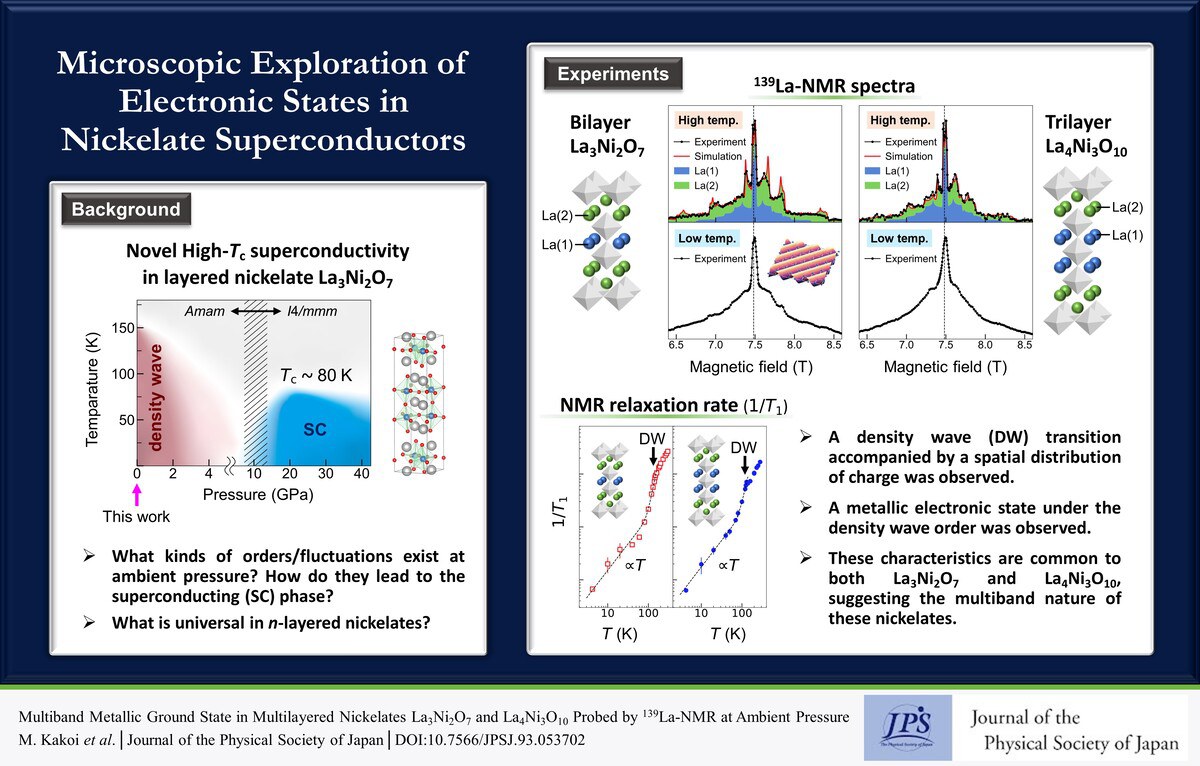Microscopic Exploration of Electronic States in Nickelate Superconductors
© The Physical Society of Japan
This article is on
Multiband Metallic Ground State in Multilayered Nickelates La3Ni2O7 and La4Ni3O10 Probed by 139La-NMR at Ambient Pressure
(JPSJ Editors' Choice)
J. Phys. Soc. Jpn.
93,
053702
(2024)
.
The multilayered nickelates, La3Ni2O7 and La4Ni3O10 , were investigated using nuclear magnetic resonance (NMR) at ambient pressure. Metallic electronic states under the density wave order were observed microscopically for both compounds.

In 2023, the discovery of the superconductivity of La3Ni2O7 with a transition temperature (Tc) of ~80 K under pressure led to nickelates joining the family of high-Tc superconductors. La3Ni2O7 has a two-layered perovskite structure resembling cuprates, which are well-known high-Tc superconductors. However, it actually possesses different characteristics from those of cuprates, anticipating a new superconducting mechanism.
One of the major mysteries of La3Ni2O7 is what kind of electronic orders and/or fluctuations exist and how they lead to the superconducting phase from the non-superconducting phase at ambient pressure. In addition, La3Ni2O7 belongs to the Ruddlesden–Popper (RP) phase Lan+1NinO3n+1, which includes similar compounds with different numbers of layers (n). Systematic studies of the RP series are expected to provide clues regarding the origin of superconductivity and the exploration of new superconductors.
We investigated the electronic states of (La3Ni2O7) (n=2) and La4Ni3O10 (n=3) at ambient pressure using nuclear magnetic resonance (NMR) experiments, which can be used to microscopically observe the orders and/or fluctuations of charge and spin. The NMR spectra at high temperatures exhibited multiple distinct peaks, which allowed us to identify two crystallographically inequivalent sites. At temperatures below 150 K for La3Ni2O7 and 130 K for La4Ni3O10, significant broadening of their spectra, particularly in the satellite peaks, was observed. This suggests the existence of a density-wave transition accompanied by a spatial charge distribution. We also measured the nuclear spin relaxation rate (1/T1), showing that, in addition to the sharp drop in 1/T1 associated with the density wave transition, the relaxation remains finite at lower temperatures. This result indicates that the system has a metallic ground state with a partial gap at the Fermi energy owing to the density-wave transition.
The fact that these characteristics are commonly observed in La3Ni2O7 and La4Ni3O10 provides important insights. These observations are likely associated with the different features of the multiple bands composed of the dx2-y2 and d3z2-r2 orbitals, which are common to these compounds. Recently, superconductivity with a of ~25 K under pressure was also discovered in La4Ni3O10. This finding suggests a connection between the multiband nature, density wave phase, and emergence of the superconducting phase under high pressure. The possibility of spin order coexisting with charge order remains debatable, and further investigations are required to understand how the charge and spin degrees of freedom evolve toward the superconducting phase under high pressure.
Written by M. Kakoi and H. Mukuda on behalf of all authors.
Multiband Metallic Ground State in Multilayered Nickelates La3Ni2O7 and La4Ni3O10 Probed by 139La-NMR at Ambient Pressure
(JPSJ Editors' Choice)
J. Phys. Soc. Jpn.
93,
053702
(2024)
.
Share this topic
Fields
Related Articles
-
Higher-Order Topological Phases in Magnetic Materials with Breathing Pyrochlore Structures
Electronic structure and electrical properties of surfaces and nanostructures
Magnetic properties in condensed matter
Mathematical methods, classical and quantum physics, relativity, gravitation, numerical simulation, computational modeling
2025-4-7
A simple example of a higher-order topological phase, in which the symmetry decreases step-by-step from the bulk to the corner, is realized in a magnetic system with a pyrochlore structure and is characterized by a series of quantized Berry phases defined for the bulk, surface, and edge.
-
Existence of Chiral Soliton Lattices (CSLs) in Chiral Helimagnet Yb(Ni1-xCux)3Al9
Magnetic properties in condensed matter
2025-4-1
Our study examines the magnetic structure of the monoaxial chiral helimagnet Yb(Ni1-xCux)3Al9, providing first direct evidence of the formation of chiral soliton lattice state.
-
Fractional Vortex Array with Nontrivial Topological Structure Realized at Twin Boundary of Nematic Superconductor
Superconductivity
2025-3-24
Analysis of the two-component Ginzburg-Landau theory suggests that a conventional vortex is transformed into two fractional vortices with the topological nature of core-down and core-up merons at the twin boundary of a nematic superconductor.
-
Exploring the Vibrant Interplay of Machine Learning and Physics
Cross-disciplinary physics and related areas of science and technology
Electron states in condensed matter
Elementary particles, fields, and strings
Mathematical methods, classical and quantum physics, relativity, gravitation, numerical simulation, computational modeling
Statistical physics and thermodynamics
Superconductivity
2025-3-13
This Journal of the Physical Society of Japan Special Topics edition explores how physics and machine learning complement each other and can solve unresolved problems in physics.
-
Understanding Pressure-Induced Superconductivity in CrAs and MnP
Magnetic properties in condensed matter
2025-3-10
This study reviews existing research on the pressure-induced variation of magnetic properties of transition metal mono-pnictides like CrAS, MnP, and others, aiming to understand the unconventional superconductivity observed in CrAs and MnP.




